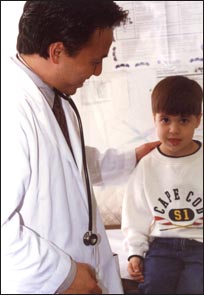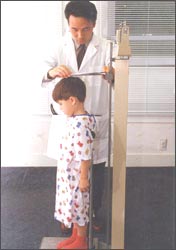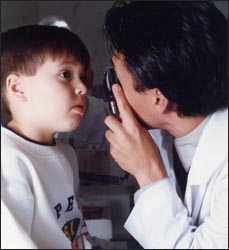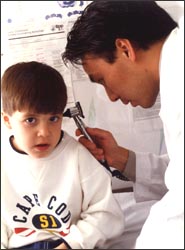소아 정기 건강검진을 받으러 갈 때 부모들이 알아야 할 일, What parents should know about your child health physical examination(Well child examination)
- 아이가 아파서 치료 받기 위해 병원이나 소아청소년과에 데리고 갈 때나 정기 건강검진을 받기 위해 아이를 데리고 병원이나 소아청소년과에 갈 때 가능한 한 목욕을 시키고 깨끗한 옷으로 갈아입히고 데리고 가는 것이 좋다. 기저귀를 차는 어린 영유아를 병원이나 소아청소년과에 데리고 갈 때는 기저귀를 여유 있게 몇 개 더 가지고 간다.
- 병원이나 소아청소년과에 가기 전 의사나 간호사에게 문의할 사항을 메모해 가지고 간다. 환아의 증상 징후를 아는 대로 메모해 가지고 가서 필요에 따라 의사에게 체계적으로 설명한다.
- 단골 소아청소년 의사가 아닌 다른 의사의 처음 진료를 받으러 갈 때는 자녀의 예방접종 기록카드와 진료 기록지 등을 가능한 한 다 가지고 간다.
- 때로는 새로 정한 소아청소년과 전문의의 처음 진료를 받으러 가기 전 단골 소아청소년과 의사가 자녀의 진료 기록지를 새로 정한 소아과 전문의에게 우편으로 보낼 수 있다. 형편에 따라 자녀의 부모가 자녀의 진료 기록지를 지침하고 갈 수 있다.
- 특히 영유아의 소변이나 대변 등 피검물이 앓는 자녀의 병을 진단, 치료하는데 필요할 때가 많다.
- 자녀가 병원이나 소아청소년과에서 진료를 받으러 가기 전 집에서 소 대변 등 피검물을 받을 수 있는 있으면 적절한 피 검물 용기에 받아 가지고 가면 그것을 요긴하게 쓸 수 있다.
- 그 동안 진료해 줬던 단골 소아청소년과 의사가 아닌 다른 소아청소년과 의사를 볼 때는 쓰던 약물도 가지고 가서 의사에게 보여준다.
- 다른 병원이나 소아청소년과에서 찰영한 X-선 검사 사진이 있거나 혈액검사 결과가 있으면 그것도 가지고 간다.
- 빈료 받을 의사들에게는 예기치 않았던 응급 환자가 갑자기 생길 수 있다. 특히 소아청소년과에서 그런 일이 더 잘 생긴다. 그럴 때 예약했던 제 시간에 환아를 검진할 수 없다. 이럴 때는 예상 외로 더 오랫동안 기다렸다가 검진 받을 수 있다.
- 검진을 받기 위해 오래 기다리는 동안, 특히 영유아들은 배가 고프거나 아파서 울고 보챌 수 있다. 이런 것을 대비해서 인공영양이나 먹을 음식물을 여유 있게 가지고 간다.
- 영유아들은 진찰을 받는 동안 두려워서 울고 더 보챌 수 있다. 이럴 때는 정확하게 진찰을 잘 할 수 없다. 그 때문에 소아청소년과 전문의들은 필요에 따라 엄마가 영유아에게 인공영양이나 모유를 먹이는 동안 진찰 한다. 이런 것을 대비하기 위해 인공영양을 여유 있게 더 가지고 간다. 또 때로는 모유를 수유하면서 진찰을 받을 수 있게 모유 수유를 간편히 할 수 있도록 준비해야 한다.
- 아이들은 순진해서 남의 말을 잘 듣는다. 병원이나 소아청소년과에 진료를 받으러 갈 때는 그들에게 거짓말을 해서는 절대로 안 된다.
- 어려서 말을 잘 알아들을 수 없고 잘 이해 못하는 어린이를 병원이나 소아과에 데리고 갈 때나 심하게 앓는 자녀를 병원이나 소아청소년과에 급히 데리고 갈 때 가능한 한 자녀에게 병원이나 소아청소년과에 가야 하는 이유, 간호사나 의사가 어떻게 무엇으로 도와 줄 것이라는 진단 치료에 관한 것 등을 간단히 대략 설명해 주고, 자녀가 질문하면 그 질문에 간단히 답변해야 한다.
- 만일을 위해, 병원 소아과에 입원을 할 수 있는 준비를 하고, 필요에 따라 다른 특수 소아과 전문의로부터 2차 검진을 받을 수 있게 준비를 해야 한다.
- 청소년과에 진료 받으러 갈 때 진찰, 진단, 치료에 관해 자녀의 나이에 적절하게 설명을 잘 해야 한다.
- 예를 들면, “오늘 네가 잘 크는지, 건강한지 알아보기 위해 소아청소년과에서 건강검진을 받으러 간다.”,
- “병원이나 소아청소년과에 가서 네가 그 동안 얼마나 컸는지 알아보려고 키와 몸무게를 재보고, 열이 나는지 알아보기 위해 체온계로 체온을 재 볼 것이다.”라고 간단히 설명해 주어야 한다.
- 또 다른 예를 들면, “네가 얼마나 건강한지 알아보기 위하여 소아청소년과에 간다. 병원이나 소아청소년과에 있는 간호사가 체온계로 체온을 재볼 것이다”라는 등등을 간단히 설명해 줘야 한다.
- 또 다른 예를 들면, “의사가 귓구멍 속을 이경이라는 다른 의료기구로 들여다볼 것이다. 불빛이 달린 기구의 끝부분을 귓구멍 속에 넣을 때 좀 찰 수 있지만 아프지는 않다.
- 손전등으로 목구멍 속을 비춰 들여다 볼 것이다.
- 혓바닥 때문에 목구멍 속을 잘 볼 수 없어 설 압자로 혓바닥을 아래로 누르고 목구멍 속을 들여다볼 것이다”.
- “심장 뛰는 소리와 폐 속으로 공기가 들어갔다 폐 속에서 공기가 나왔다 하는 숨소리를 청진기로 들어볼 것이다”.
- “먹은 음식물이 위장관 속으로 들어가서 소화가 잘 되는지 알아보기 위해 배도 만져볼 것이다”라고 자녀의 나이와 성숙도에 따라, 때로는 그림으로 간단히 설명해 주어야 한다.
- 진찰을 받고 필요에 따라 피검사를 하기 위해 “피를 조금 뽑을 것이라는 것과 피를 뽑을 때는 조금 아플 것”이라는 것을 솔직히 말해 주어야 한다.
- 예방접종을 받기 위해 병원이나 소아청소년과에 갈 때는 예방접종을 받아야 하는 이유를 간단히 설명해야 한다.
- “감염병을 예방해 주지 않으면 나쁜 박테리아 감염으로 나쁜 감염병에 걸릴 수 있고, 그 병으로 인해 심하게 앓을 수 있고 병원이나 소아청소년과에 입원해서 여러 날 치료를 받을 수도 있고, 그 병을 치료하기 위해서 주사를 여러 번 맞아야 할지도 모르고, 그 병을 앓다가 위험한 일도 생길 수 있다”고 잘 설명해 주어야 한다.
- 병원이나 소아청소년과에 갈 때 필요에 따라 모든 것을 솔직히 간단하게 말해 주어야 한다.
- “예방접종 백신 주사를 맞을 때 조금 아플 수 있지만 박테리아 감염병으로 나쁜 병에 걸리지 않도록 예방접종 백신 주사를 미리 맞는 것이 예방접종 백신 주사를 안 맞아 위험한 감염병에 걸려 앓는 것보다 훨씬 낫다”고 설명해 준다.
- 이런 설명은 가급적이면 병원이나 소아청소년과에서 설명해 주는 것보다 병원이나 소아청소년과에 가기 전 집에서 설명해 주어야 한다.
- 병원이나 소아청소년과를 가기 싫어 할 때는 거짓말로 타 이르지 말고 참말로 타이르면서 병원이나 소아청소년과에 데리고 가야 한다.
- 가령 유아 자녀에게 “오늘은 병원이나 소아청소년과에 가서 네 의사로 부터 진찰만 받고 주사는 맞지 않고 약만 타 가지고 올 것이다”라고 거짓말을 했다가 의사한테 주사 맞고 아프면 그 후 그 자녀는 부모도 믿지 않고 의사도 더 이상 믿지 않을 것이다.
- 그 후 병원이나 소아청소년과에 또 다시 가야할 때 그 자녀는 부모나 간호사, 또는 의사의 말을 더 이상 믿지 않을 것이고, 병원이나 소아청소년과 가지 않으려고 온갖 술수를 다 부릴 수 있을 것이다.
- 저자의 경험 하나를 여기에 적어 보기로 한다.
- 5세 남아가 다리에 입은 가벼운 찰과상이 곪아서 저의 소아청소년과로 엄마와 같이 왔었다.
- 이 아이가 소아과 문을 열고 들어서자마자 엉엉 울기 시작했다.
- 소아청소년과에 들어서자마자 발버둥을 치다가 결국 소아청소년과의 뒷문을 박차고 길거리로 혼자 뛰어 나갔다.
- 소아청소년과 밖에서 소아청소년과 안으로 강제로 그 아이를 데리고 와서 그 아이의 엄마와 간호사와 내가 전력을 다해서 달래면서 치료를 받아야하는 이유와 치료하는 방법을 설명해 주었다.
- 그러나 그 아이는 완강히 치료 받기를 거절했다.
- 할 수 없이 그 아이를 강제로 꼭 붙잡고 곪은 상처를 거즈로 살살 살균치료 하고 항생제 연고를 바르고 곪은 상처를 거즈로 덮고 붕대로 감아 주었다.
- “치료가 다 끝났다”고 일어나 가라고 했다.
- 그러자 그 아이가 진찰대에서 벌떡 일어나더니 나를 꼭 껴안으면서 “의사 선생님 미안해요. I love you, 집에 있는 형이 ‘네가 소아청소년과에 가면 의사 선생님이 네 다리를 칼로 자를 것이다.’라고 말 했어요.
- 그래서 저는 의사선생님이 제 다리를 자를 것이라고 생각했어요.”라고 말했다.
- 그런데 “의사선생님이 하나도 아프지 않게 치료해 주셔 고맙습니다.”라고 인사 하고 나를 꼭 껴안아 주고 엄마와 같이 소아청소년과를 나갔다.
- 아이들도 성인들도 병원이나 소아청소년과에 진료 받으러 갈 때 가지고 있는 병으로 두려워하고 병원이나 소아청소년과에 가는 그 사실만으로 두려워 할 때가 많다.
- 그러므로 병원이나 소아청소년과에 자녀를 데리고 진료 받으러 갈 때에는 자녀가 병원이나 소아청소년과에 가는 두려움을 갖지 않게 병원이나 소아과에 가는 이유를 미리 잘 설명해 주어야 한다.
- 거짓말을 하지 말고!!!!!!!!!!!!!!!
- 물론 거짓말은 평소에도 하지 말고.
- [부모도 반의사가 되어야 한다-소아가정간호백과]-제 22권 아들 딸 이렇게 키우시오-패그스 증후군, 3 Ds 반응참조

사진 160. 의사가 신체의 어느 부위를 어떻게 진찰할 것을 아이에게 자세히 설명한다.
Copyright ⓒ 2011 John Sangwon Lee, MD., FAAP

사진 161. 체중과 신장을 재고 성장 차트에 그려보고 몇 퍼센타일로 자라나 알아본다.
Copyright ⓒ 2011 John Sangwon Lee, MD., FAAP

사진 162. 키를 재고 성장차트에 그려 몇 퍼센타일로 키가 자라나 알아본다.
Copyright ⓒ 2011 John Sangwon Lee, MD., FAAP

사진 163. 안 검경으로 눈을 진찰한다.
Copyright ⓒ 2011 John Sangwon Lee, MD., FAAP

사진 165. 입안, 인두, 편도 등을 진찰한다.
Copyright ⓒ 2011 John Sangwon Lee, MD., FAAP

사진 164. 귓구멍과 외이도, 고막, 중이 등을 이경으로 진찰한다.
Copyright ⓒ 2011 John Sangwon Lee, MD., FAAP
What parents should know about your child health physical examination(Well child examination)
• When taking a child to a hospital or pediatric department for treatment because he or she is sick, or taking a child to a hospital or pediatric department for regular health check-ups, it is recommended to take a bath and change into clean clothes as much as possible. When taking infants who wear diapers to hospitals or pediatrics, take a few extra diapers with you.
• Before going to the hospital or pediatric department, take notes with your doctor or nurse and take them with you. Take notes of your child’s symptoms as soon as you know them, and systematically explain them to your doctor as needed.
• When you go to see a doctor other than your regular pediatrician for the first time, take your child’s immunization record card and medical records as much as possible.
• Sometimes, before your new pediatrician’s first visit, your regular pediatrician may mail your child’s medical records to the new pediatrician. Depending on the circumstances, the parent of the child may guide the child’s medical record sheet.
• In particular, it is often necessary to diagnose and treat the disease of a child suffering from a specimen such as urine or feces of infants or young children.
• Before your child goes to the hospital or pediatric department for medical treatment, if you can receive specimens such as feces and feces at home, you can use them in an appropriate container for specimens and take them with you.
• When you see a pediatrician other than your regular pediatrician who has treated you, bring your medications and show them to the doctor.
• If you have an X-ray or blood test result from another hospital or pediatric department, take it with you.
• Unexpected emergencies can happen suddenly for poorly ill doctors. This is especially the case in pediatrics. In that case, the patient cannot be screened at the scheduled time. In this case, you may have to wait longer than expected before being tested.
• While waiting for a long time for a check-up, especially young children, they may cry and vomit because they are hungry or sick. In preparation for this, take artificial nutrition or food to eat with plenty of time.
• Infants and toddlers may cry and be more irritable while they are being examined. In this case, it is not possible to conduct an accurate examination. For that reason, pediatric specialists, if necessary, consult while mothers are feeding their infants or infants with artificial nutrition or breast milk. To prepare for this, take more artificial nutrition with plenty of room. Also, sometimes you need to prepare for breastfeeding so that you can see a doctor while breastfeeding.
• Children are naive and listen well. When you go to a hospital or a pediatric department for treatment, you should never lie to them.
• When taking a child who is young and unable to understand speech to a hospital or pediatrician, or when a seriously ill child is rushed to the hospital or pediatric department, as far as possible, tell your child why he or she should go to the hospital or pediatrician, nurse or pediatrician. You should briefly outline the diagnosis, treatment, etc., how the doctor will help you, and briefly answer any questions your child asks.
• Be prepared for admission to the hospital’s pediatric department, just in case, for a second check-up from another special pediatrician if necessary.
• When you go to the youth department for treatment, you must explain the diagnosis, diagnosis, and treatment appropriate to your child’s age.
• For example, “Today, you are going to the Pediatric Department for a health checkup to see if you are growing and healthy.”
• Briefly explain, “Go to the hospital or pediatric department and measure your height and weight to see how tall you have grown, and take your temperature with a thermometer to see if you have a fever.”
• Another example should be briefly explained, “I am going to the pediatrician to see how healthy you are. The nurse in the hospital or pediatric department will take your temperature with a thermometer.”
• Another example: “The doctor will look into the ear canal with another medical instrument called an otoscope. When the tip of the lighted instrument is inserted into the ear canal, it may sting a little, but it does not hurt.
• You will look into your throat with a flashlight.
• I can’t see well into the throat because of the tongue, so I will press the tongue down with a tongue depressor and look into the throat”.
• “A stethoscope will hear your heart beating and breathing air in and out of your lungs”.
• Depending on your child’s age and maturity, you should briefly explain, sometimes with pictures, “I will also touch my stomach to see if the food I ate goes into the gastrointestinal tract and is digested.”
• Be honest and tell them that “a little blood will be drawn and it will hurt a little bit” to see your doctor and, if necessary, have a blood test done.
• When you go to the hospital or pediatric department to get vaccinated, you should briefly explain why you need to be vaccinated.
• “If you do not prevent an infectious disease, you can get a bad infectious disease due to a bad bacterial infection, you can get seriously ill from the disease, you can be hospitalized or pediatrician for several days, and you can get injections to treat the disease. You may have to be beaten several times, and dangerous things can happen while suffering from the disease.”
• When you go to the hospital or pediatric department, tell everything frankly and simply as needed.
• Explains, “You may get a little sick when you get the vaccine, but it’s much better to get a vaccine ahead of time so you don’t get bad from a bacterial infection than to get a dangerous infection because you don’t get vaccinated.”
• These explanations should preferably be explained at home before going to the hospital or pediatric department rather than at the hospital or pediatric department. • When you do not want to go to the hospital or pediatric department, do not lie and take it to the hospital or pediatric department by telling the truth.
• For example, if you lie to your infant child and say, “Today, I will go to the hospital or the pediatric department and get an examination from your doctor, and I will bring you only medicines, not injections.” And the doctor won’t trust you any more.
• The next time she has to go to the hospital or pediatrician again, the child will no longer believe her parents, nurses, or doctors, and will do all kinds of tricks to avoid going to the hospital or pediatrician.
• I would like to write one of the author’s experiences here.
o A 5-year-old boy came to my pediatric department with his mother because of a slight abrasion on his leg.
o As soon as this child opened the door to her pediatrician and walked in, she started crying. o She struggled with her as soon as she entered the pediatric unit, eventually spurting the pediatric unit’s back door and running alone into the street.
o The child was forcibly brought from outside the pediatric department into the pediatric department, and the child’s mother, nurse, and I did everything we could to comfort him and explain why he needed treatment and how to treat it.
o But the child stubbornly refused treatment.
o He forced the child to hold her tight, gently sterilized her sore wound with gauze, applied antibiotic ointment, and covered her sore wound with gauze and bandaged it.
o She said “the treatment is over” and told her to get up and go.
o Then the child jumped up from the examination table, hugged me tightly, and said, “I’m sorry, doctor. I love you, the older brother at home said, ‘If you go to the pediatrician, the doctor will cut your leg off with a knife.’ .
o So I thought the doctor would have my leg amputated,” he said.
o By the way, I said, “Thank you, the doctor, for treating me without any pain.” He hugged me tightly and left the pediatrics department with her mother.
• Children and adults alike are often afraid of the disease they have when they go to a hospital or pediatric department, and often fear just the fact that they go to the hospital or pediatric department.
• Therefore, when taking your child to a hospital or pediatric department for treatment, you should explain the reason for going to the hospital or pediatric department well in advance so that your child will not be afraid of going to the hospital or pediatric department.
• Don’t lie!!!!!!!!!!!!!
• Of course, don’t lie on a regular basis.
www.drleepediatrics.com – Volume 22 Raising Sons and Daughters Like This – See Paggs Syndrome, 3 Ds Reaction

Picture 160. Explain to the child in detail what part of the body the doctor will examine and how. Copyright ⓒ 2011 John Sangwon Lee, MD., FAAP

Picture 161. Measure your weight and height, plot it on a growth chart, and see how many percentiles you are growing. Copyright ⓒ 2011 John Sangwon Lee, MD., FAAP

Picture 162. Measure your height and draw it on a growth chart to see how many percent your height is. Copyright ⓒ 2011 John Sangwon Lee, MD., FAAP

Picture 163. Examination of the eye with ophthalmoscopy. Copyright ⓒ 2011 John Sangwon Lee, MD., FAAP

Picture 165. Examine the mouth, pharynx, and tonsils. Copyright ⓒ 2011 John Sangwon Lee, MD., FAAP

Photo 164. Examine the ear canal, external auditory canal, tympanic membrane, and middle ear with an otoscope. Copyright ⓒ 2011 John Sangwon Lee, MD., FAAP
출처 및 참조 문헌 Sources and references
- NelsonTextbook of Pediatrics 22ND Ed
- The Harriet Lane Handbook 22ND Ed
- Growth and development of the children
- Red Book 32nd Ed 2021-2024
- Neonatal Resuscitation, American Academy of Pediatrics
-
Oral Health The Pediatric Clinics of North America, Stuart D.Josell
-
Pediatric Oral Health Stuart Jose
-
Ann L. Griffen, DDS, MS
-
Atlas Pediatric Physical Diagnosis Frank A Oski
- www.drleepediatrics.com 제1권 소아청소년 응급 의료
- www.drleepediatrics.com 제2권 소아청소년 예방
- www.drleepediatrics.com 제3권 소아청소년 성장 발육 육아
- www.drleepediatrics.com 제4권 모유,모유수유, 이유
- www.drleepediatrics.com 제5권 인공영양, 우유, 이유식, 비타민, 미네랄, 단백질, 탄수화물, 지방
- www.drleepediatrics.com 제6권 신생아 성장 발육 육아 질병
- www.drleepediatrics.com제7권 소아청소년 감염병
- www.drleepediatrics.com제8권 소아청소년 호흡기 질환
- www.drleepediatrics.com제9권 소아청소년 소화기 질환
- www.drleepediatrics.com제10권. 소아청소년 신장 비뇨 생식기 질환
- www.drleepediatrics.com제11권. 소아청소년 심장 혈관계 질환
- www.drleepediatrics.com제12권. 소아청소년 신경 정신 질환, 행동 수면 문제
- www.drleepediatrics.com제13권. 소아청소년 혈액, 림프, 종양 질환
- www.drleepediatrics.com제14권. 소아청소년 내분비, 유전, 염색체, 대사, 희귀병
- www.drleepediatrics.com제15권. 소아청소년 알레르기, 자가 면역질환
- www.drleepediatrics.com제16권. 소아청소년 정형외과 질환
- www.drleepediatrics.com제17권. 소아청소년 피부 질환
- www.drleepediatrics.com제18권. 소아청소년 이비인후(귀 코 인두 후두) 질환
- www.drleepediatrics.com제19권. 소아청소년 안과 (눈)질환
- www.drleepediatrics.com 제20권 소아청소년 이 (치아)질환
- www.drleepediatrics.com 제21권 소아청소년 가정 학교 간호
- www.drleepediatrics.com 제22권 아들 딸 이렇게 사랑해 키우세요
- www.drleepediatrics.com 제23권 사춘기 아이들의 성장 발육 질병
- www.drleepediatrics.com 제24권 소아청소년 성교육
- www.drleepediatrics.com 제25권 임신, 분만, 출산, 신생아 돌보기
- Red book 29th-31st edition 2021
- Nelson Text Book of Pediatrics 19th- 21st Edition
- The Johns Hopkins Hospital, The Harriet Lane Handbook, 22nd edition
- 응급환자관리 정담미디어
- Pediatric Nutritional Handbook American Academy of Pediatrics
- 소아가정간호백과–부모도 반의사가 되어야 한다, 이상원 저
- The pregnancy Bible. By Joan stone, MD. Keith Eddleman, MD
- Neonatology Jeffrey J. Pomerance, C. Joan Richardson
- Preparation for Birth. Beverly Savage and Dianna Smith
- 임신에서 신생아 돌보기까지. 이상원
- Breastfeeding. by Ruth Lawrence and Robert Lawrence
- Sources and references on Growth, Development, Cares, and Diseases of Newborn Infants
- Emergency Medical Service for Children, By Ross Lab. May 1989. p.10
- Emergency care, Harvey Grant and Robert Murray
- Emergency Care Transportation of Sick and Injured American Academy of Orthopaedic Surgeons
- Emergency Pediatrics A Guide to Ambulatory Care, Roger M. Barkin, Peter Rosen
- Quick Reference To Pediatric Emergencies, Delmer J. Pascoe, M.D., Moses Grossman, M.D. with 26 contributors
- Neonatal resuscitation Ameican academy of pediatrics
- Pediatric Nutritional Handbook American Academy of Pediatrics
- Pediatric Resuscitation Pediatric Clinics of North America, Stephen M. Schexnayder, M.D.
-
Pediatric Critical Care, Pediatric Clinics of North America, James P. Orlowski, M.D.
-
Preparation for Birth. Beverly Savage and Dianna Smith
-
Infectious disease of children, Saul Krugman, Samuel L Katz, Ann A.
-
Emergency Care Transportation of Sick and Injured American Academy of Orthopaedic Surgeons
-
Emergency Pediatrics A Guide to Ambulatory Care, Roger M. Barkin, Peter Rosen
-
Gray’s Anatomy
-
제19권 소아청소년 안과 질환 참조문헌 및 출처
- Habilitation of The handicapped Child, The Pediatric Clinics of North America, Robert H Haslam, MD.,
-
Pediatric Ophthalmology, The Pediatric Clinics of North America, Leonard B. Nelson, M.D.
-
Pediatric Ophthalmology, The Pediatric Clinics of North America, Lois J. Martyn, M.D.
-
Pediatric Ophthalmology, Edited by Robison D. Harley, M.D.
-
The Pediatric Clinics of North America, David Tunkel, MD., Kenneth MD Grundfast, MD
Copyright ⓒ 2014 John Sangwon Lee, MD., FAAP
“부모도 반의사가 되어야 한다”-내용은 여러분들의 의사로부터 얻은 정보와 진료를 대신할 수 없습니다.
“The information contained in this publication should not be used as a substitute for the medical care and advice of your doctor. There may be variations in treatment that your doctor may recommend based on individual facts and circumstances.
“Parental education is the best medicine.